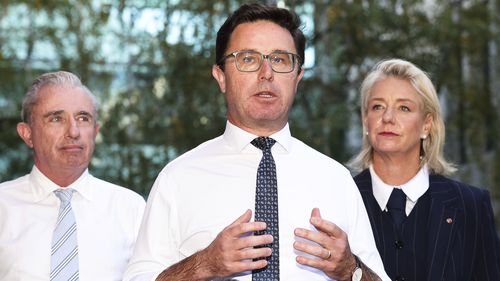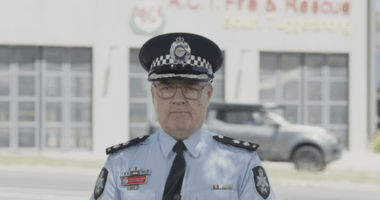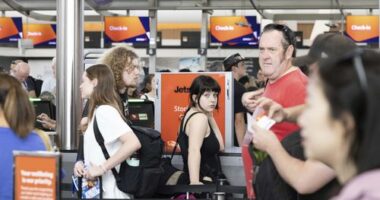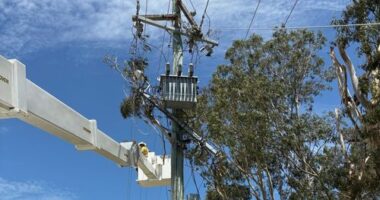Share this @internewscast.com
The end of the Liberals’ and Nationals’ decades-long partnership has been labelled a “seismic” and “nuclear” event in our recent political history.
Nationals leader David Littleproud and Liberal leader Sussan Ley were unable to finalize a new Coalition agreement yesterday, following a collapse in negotiations conducted from her family home in Albury.
The Liberals are now the sole opposition party, and the Nationals are a minority.
But what does any of this actually mean?

Why did the Coalition split? 
Littleproud and Ley failed to negotiate a new Coalition agreement following a historic and devastating loss at the federal election on May 3.
Typically, the nature of these talks is kept quiet, but both leaders were forthcoming when they faced reporters yesterday afternoon.
Littleproud stated that his party was seeking commitments on four key policies: nuclear energy, a regional Australia future fund, supermarket divestiture, and regional telephone service obligations. 
Ley, after being elected new Liberal leader last week, said all policies would be reviewed and she would not make any captain’s calls.

This was a point she reiterated when she faced the media yesterday. 
“Our standpoint isn’t solely about the individual policies, but the method we pledged to adopt regarding policies in our party room, where nothing is adopted and nothing is abandoned,” she explained.
Ley added that she proposed a joint shadow ministry, comprised of both Liberal and Nationals members, who would work separately on policies in their own party rooms before coming together and debating those policies.
She hoped the Coalition would then present a “united front” and a “united agenda” to Australians. 
“The Nationals did not agree to that approach,” she said.

How does the Coalition split affect parliament?
The official opposition, the largest non-elected party or group, is now the Liberals rather than the Coalition. 
Ley is currently drawing up her shadow ministry, which will be filled from her party room, and will have portfolios assigned in the coming days.
This means the Liberals will hold all the frontbench positions and have greater power. 
The Nationals now form a minor party, and their MPs and Senators will sit by themselves in parliament, similar to the Greens and independents.

What does the split mean for the Labor government?
The split is unlikely to change much in the House of Representatives, where Labor holds a majority of the seats and does not need any support to pass legislation.
But, it could see things change in the Senate.
Labor needs support from either the Liberals or the Greens to pass legislation.
If the Liberals and Greens oppose, Labor will need support from the Nationals as well as most of the crossbench in order to pass legislation.
However, this scenario will be unlikely, as the Liberals and Nationals typically vote in a similar way.
Treasurer Jim Chalmers said the Labor government was “focused on governing” while the former Coalition were “focused inwardly on themselves”.
“It is a seismic event in our political history,” he said yesterday.
“It’s a nuclear meltdown. They are a smoking ruin.”

Will the federal change affect the LNP and CLP?
The Liberal National Party in Queensland and the Country Liberal Party in the Northern Territory govern as merged political groups.
The federal split will not have any effect on the state and territory parties.
LNP and CLP MPs or Senators can choose which party room they sit in when they come to Canberra.
They will all likely remain in the party room they have aligned themselves with.
The only exception is CLP Senator Jacinta Price, who defected from the Nationals to the Liberals in a bid to become deputy leader under Angus Taylor.

Will the Liberals and Nationals work together again?
The Coalition split is looking to be a trial separation rather than a divorce.
Both leaders signalled they hoped to return to an agreement in the future and poured water on any speculation of tensions between the pair.
“(Sussan and I) had a great hug at the end of it, when I went around and told her the formal notification of our position,” Littleproud told ABC Radio National.
Littleproud said he expects an agreement to be reached sometime before the next federal election, adding that the time apart would allow Ley to determine the Liberals’ path forward following Peter Dutton’s landslide election defeat. 
Ley, a self-proclaimed Coalitionist, said she would continue to work with the Nationals in the meantime.
She also touched on the Liberal election win in 1996, when the party secured enough seats to govern in its own right but chose to honour its agreement with the Nationals.
“That is exactly the approach I will take,” she said.

Albanese celebrates victory with coffee
Has the Coalition split before? 
This is the Coalition’s fourth separation since it was founded in 1944.
The Liberals and Nationals failed to form a combined opposition after Gough Whitlam’s election victory in 1972.
They reformed in time for the election in 1974. 
More than 10 years later, the Coalition broke up after a campaign from the Queensland Nationals premier Joh Bjelke-Petersen to become prime minister.
The Coalition also briefly parted from April to August 1987 but came back together in the aftermath of Bob Hawke’s landslide Labor win that year.
Yesterday’s split is the first time the parties have separated in almost 40 years. 











